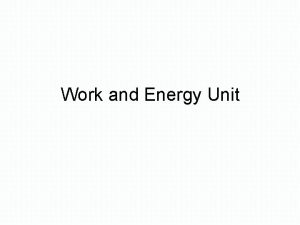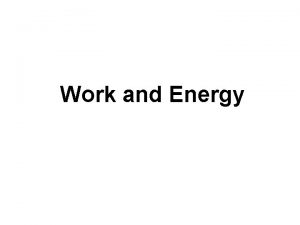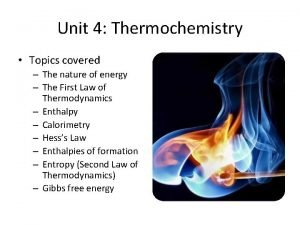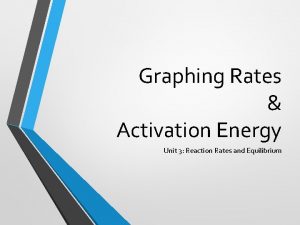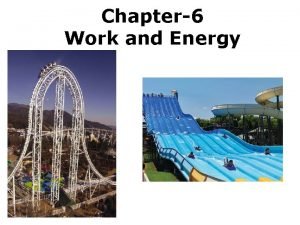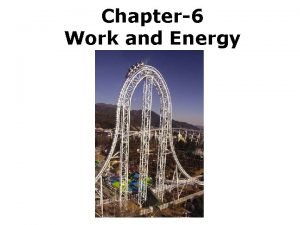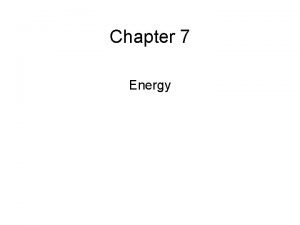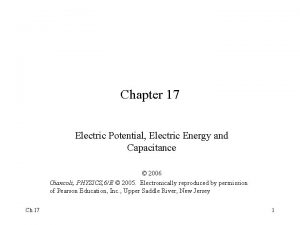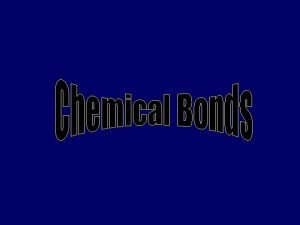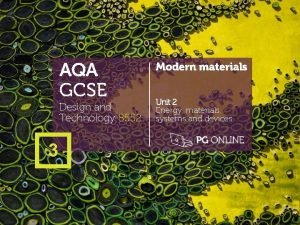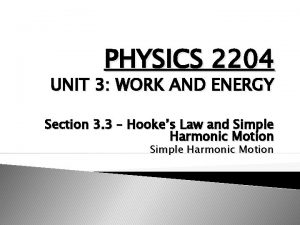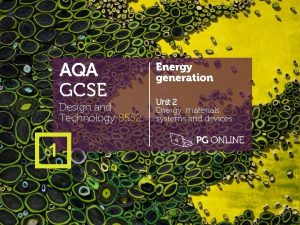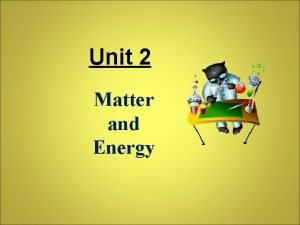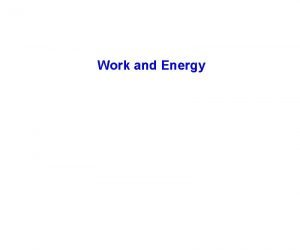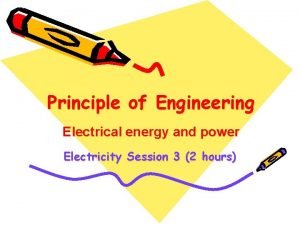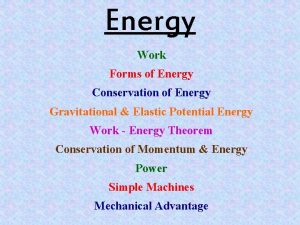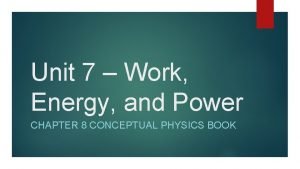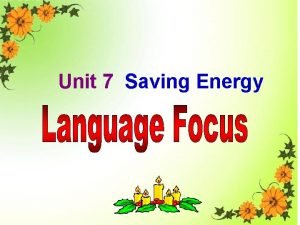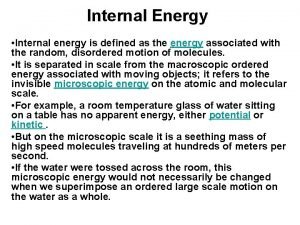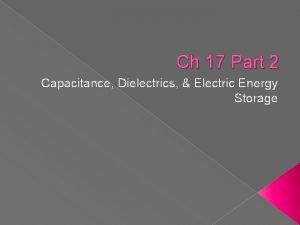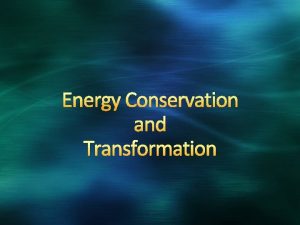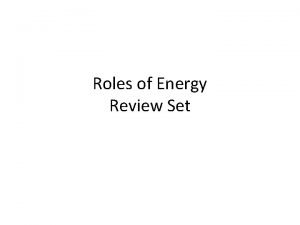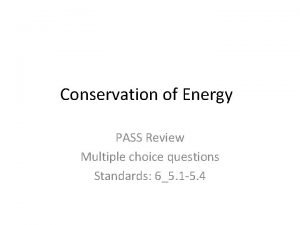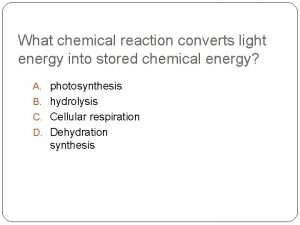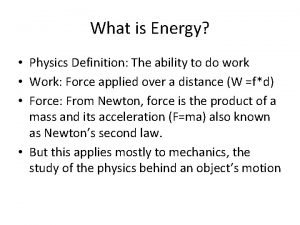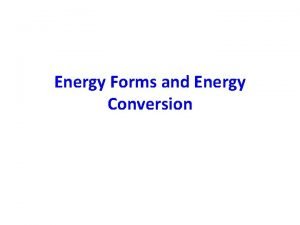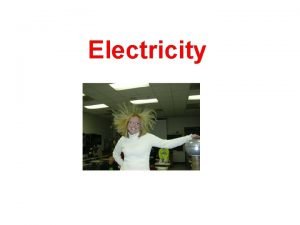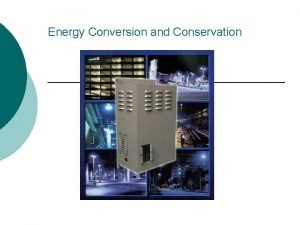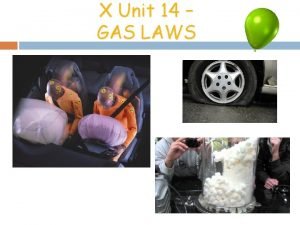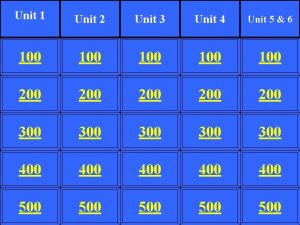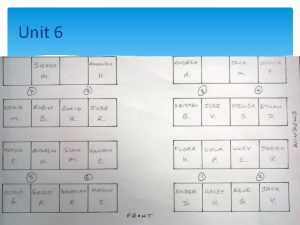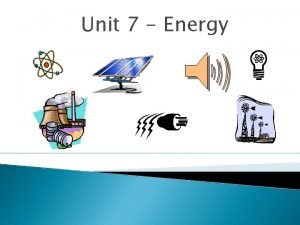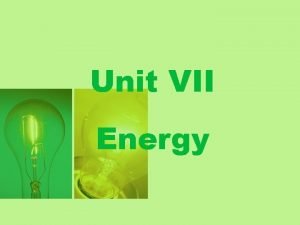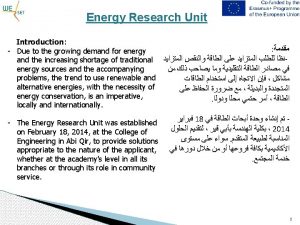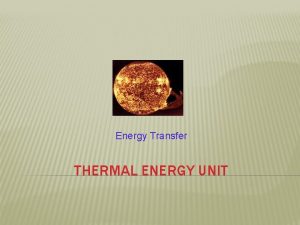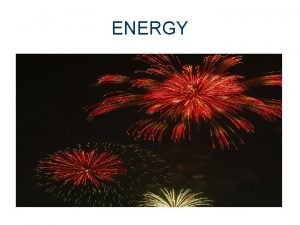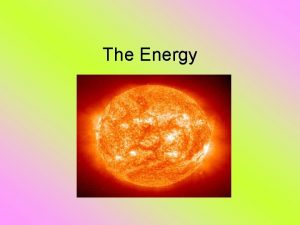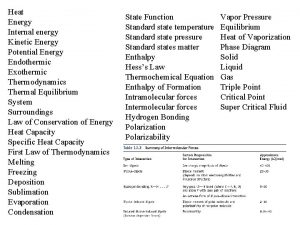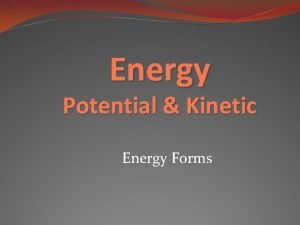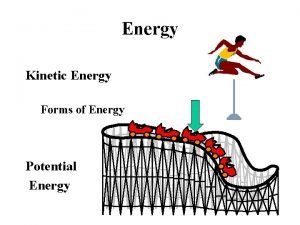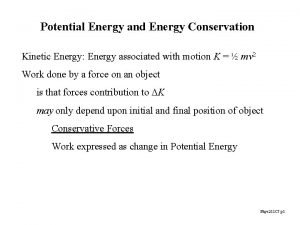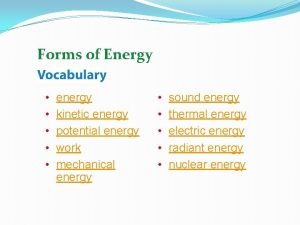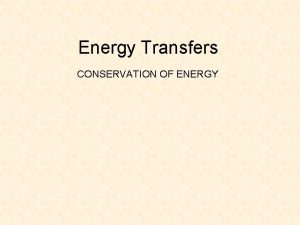Unit 2 Energy What is energy Energy is












































































- Slides: 76

Unit 2 Energy

What is energy? �Energy is the ability to cause change and DO WORK!

Types of Energy �Kinetic and Potential

Kinetic Energy �Energy of an object due to its motion. �Mass and Speed are factors of kinetic energy.

Potential Energy �Energy that an object has due to its position or chemical composition


Examples of Potential Energy �Gravitational �Elastic �Chemical






Law of Conservation of Energy �Energy cannot be created or destroyed. It can only be transferred.


Temperature �Is a measure of the amount of kinetic energy (motion of the particles)


Kinetic Theory of Matter �States that all particles that make up matter are constantly in motion

Motion of Particles �Warmer objects particles move faster than that of cooler objects.

Measurement of Temperature �Thermometer in degrees Fahrenheit and Celsius

Fahrenheit and Celsius

Heat �Energy is transferred from objects of higher temperatures to objects with lower temperatures

Ways of Heat Transfer �Conduction, Convection and Radiation

Conduction �Transfer of energy as heat from one substance to another (contact/touch)


Insulator �A poor conductor of heat

Convection �Transfer of energy as heat by movement of liquids or gases �Warm air, rises �Cold air, sinks


Radiation �Can travel through empty space.


How do we use energy in our daily lives?


Sources of Energy �Available source of stored energy that humans can use

Energy Sources �Renewable and Non-Renewable

Renewable �Can be easily reproduced or replaced by nature �Usually nonpolluting, no greenhouse gases

Examples of Renewable Energy These energy sources are alternatives to fossil fuels! �Hydroelectric �Wind �Geothermal �Biomass �Solar �Hydrogen



Hydroelectric �Energy from large volumes of water spinning a turbine �Negative---flooding of land which destroys habitats




Wind �Blowing wind causes the blades of a turbine to spin

Wind �Negatives--location and weather dependent





Geothermal �Steam generated from the inside of the Earth spins the turbine



Biomass �Living or recently dead organic material �Trees, Crops, Trash


Solar �Energy from the sun



Hydrogen �Most abundant element in the universe.


Nonrenewable �Cannot be produced, grown, or restored as fast as it is used

Examples of Non-Renewable �Fossil Fuels and Nuclear

Fossil Fuels �Coal, Petroleum (Oil), Natural Gas

Coal �Solid, sedimentary rock formed from the remains of dead plants and animals at the bottom of swamps




Petroleum �“Rock oil” �This liquids is used to create gasoline, diesel, and jet fuel.



Natural Gas �Gas trapped in rock formations

Nuclear �Splitting atoms of uranium







 Unit 6 review questions
Unit 6 review questions Energy energy transfer and general energy analysis
Energy energy transfer and general energy analysis Energy energy transfer and general energy analysis
Energy energy transfer and general energy analysis Metode pembiayaan langsung (direct financing method)
Metode pembiayaan langsung (direct financing method) Right triangle trigonometry
Right triangle trigonometry Si vs english units
Si vs english units Algebra 2 unit 1 test
Algebra 2 unit 1 test Perhitungan unit cost rekam medis
Perhitungan unit cost rekam medis Unit process and unit operation
Unit process and unit operation Difference between unit process and unit operation
Difference between unit process and unit operation Kerangka konseptual standar akuntansi pemerintahan
Kerangka konseptual standar akuntansi pemerintahan Lawn mower energy transformation
Lawn mower energy transformation Formula of potential energy
Formula of potential energy Thermochemistry
Thermochemistry Activation energy unit
Activation energy unit Gibbs free energy non standard conditions
Gibbs free energy non standard conditions Energy and forces unit test
Energy and forces unit test Si unit for kinetic energy
Si unit for kinetic energy Si unit for kinetic energy
Si unit for kinetic energy The most energy per unit mass can be extracted from
The most energy per unit mass can be extracted from Electric potential energy of capacitor
Electric potential energy of capacitor Gibbs free energy
Gibbs free energy Small unit of matter
Small unit of matter Unit 2 energy materials systems and devices
Unit 2 energy materials systems and devices Unit 3 force motion energy answer key
Unit 3 force motion energy answer key Physics 2204 unit 3: work, power, energy
Physics 2204 unit 3: work, power, energy Unit 2 energy, materials, systems and devices answers
Unit 2 energy, materials, systems and devices answers Unit 2 matter and energy
Unit 2 matter and energy Newton metre is the unit of energy
Newton metre is the unit of energy Unit 6 language focus
Unit 6 language focus Mks unit of energy
Mks unit of energy Si units of potential energy
Si units of potential energy Jenis usaha apa
Jenis usaha apa  0:00 / 0:01    
 0:00 / 0:01     What is internal energy
What is internal energy A camera flash unit stores energy in a 150
A camera flash unit stores energy in a 150 Chemical potential energy images
Chemical potential energy images Elastic energy to kinetic energy
Elastic energy to kinetic energy Primary energy and secondary energy
Primary energy and secondary energy Disadvantages of conventional energy
Disadvantages of conventional energy Standard free energy change
Standard free energy change Efficiency equation
Efficiency equation How are thermal energy and temperature different
How are thermal energy and temperature different A hairdryer converts ____ energy into ____ energy.
A hairdryer converts ____ energy into ____ energy. Power energy relation
Power energy relation How to convert mechanical energy to electrical energy
How to convert mechanical energy to electrical energy Thermal energy section 3 using thermal energy
Thermal energy section 3 using thermal energy Helmholtz free energy and gibbs free energy
Helmholtz free energy and gibbs free energy As nutritional energy passes through the food chain, energy
As nutritional energy passes through the food chain, energy As a roller coaster goes downhill
As a roller coaster goes downhill Chapter 7 energy conservation of energy
Chapter 7 energy conservation of energy Indirect solar energy
Indirect solar energy ________ converts light energy into chemical energy. *
________ converts light energy into chemical energy. * Formula for total mechanical energy
Formula for total mechanical energy Chemical potential energy examples pictures
Chemical potential energy examples pictures Mention the expression
Mention the expression Definition of energy physics
Definition of energy physics What is mechanical energy
What is mechanical energy Gravitational potential energy vs kinetic energy
Gravitational potential energy vs kinetic energy How to calculate useful energy output
How to calculate useful energy output Mass and thermal energy
Mass and thermal energy Renewable energy and energy efficiency partnership
Renewable energy and energy efficiency partnership What is kinetic and potential energy
What is kinetic and potential energy Potential energy
Potential energy Kinetic energy
Kinetic energy Gravitational potential energy
Gravitational potential energy Kinetic energy and potential energy formula
Kinetic energy and potential energy formula Eroei
Eroei Working of electric motor
Working of electric motor In an energy pyramid where is the most energy
In an energy pyramid where is the most energy Photosynthesis transforms light energy into chemical energy
Photosynthesis transforms light energy into chemical energy Energy conversion and conservation
Energy conversion and conservation Chapter 8 section 1 how organisms obtain energy answer key
Chapter 8 section 1 how organisms obtain energy answer key Vocabulary from latin and greek roots unit 8
Vocabulary from latin and greek roots unit 8 Ygfc york
Ygfc york What happens to gas when the temperature decreases
What happens to gas when the temperature decreases Explain factors to consider when proposing dishes for menus
Explain factors to consider when proposing dishes for menus











